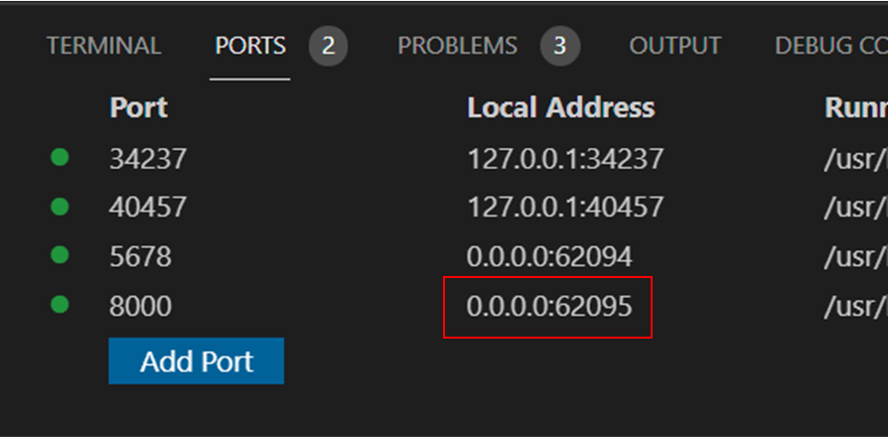Docker dynamic ports ¶
Docker dynamically assigns host machine ports that map into container application ports.
Inside the Devcontainer ¶
Info
The Devcontainer can bind to a single container’s port(s) and present those to your localhost machine via VS Code. Other services started along with the Devcontainer are not visible in VS Code. See Outside the Devconatiner for how to find information on those.
Once started with F5, the benefits Django application runs on port 8000 inside the Devcontainer. To find the localhost
address, look on the PORTS tab in VS Code’s Terminal window. The Local Address corresponding to the record where
8000 is in the Port column is where the site is accessible on your host machine.
Replace 0.0.0.0 with localhost and use the same port number shown in the Local Address column. This is highlighted by the
red box in the image below:

Outside the Devcontainer ¶
When running a docker compose ... command, or in other scenarios outside of the Devcontainer, there are multiple ways to find
the http://localhost port corresponding to the service in question.
Docker Desktop ¶
The Docker Desktop application shows information about running containers and services/groups, including information about bound ports. In most cases, the application provides a button to launch a container/service directly in your browser when a port binding is available.
In the Containers / Apps tab, expand the service group if needed to find the container in question, where you should see
labels indicating the container is RUNNING and bound to PORT: XYZ.
Hover over the container in question, and click the Open in Browser button to launch the app in your web browser.

Docker CLI commands ¶
Using the docker command line interface, you can find the bound port(s) of running containers.
docker ps -f name=<service>
e.g. for the docs service:
docker ps -f name=docs
This prints output like the following:
CONTAINER ID IMAGE COMMAND CREATED STATUS PORTS NAMES
0d5b2e1fb910 benefits_client:dev "mkdocs serve --dev-…" 2 minutes ago Up 2 minutes 0.0.0.0:62093->8000/tcp benefits_docs_1
Looking at the PORTS column:
PORTS
0.0.0.0:62093->8000/tcp
We can see that locally, port 62093 is bound to the container port 8000.
In this case, entering http://localhost:62093 in the web browser navigates to the docs site homepage.